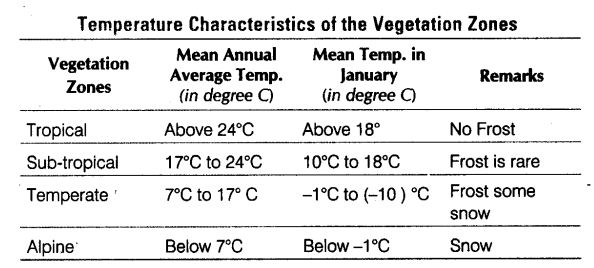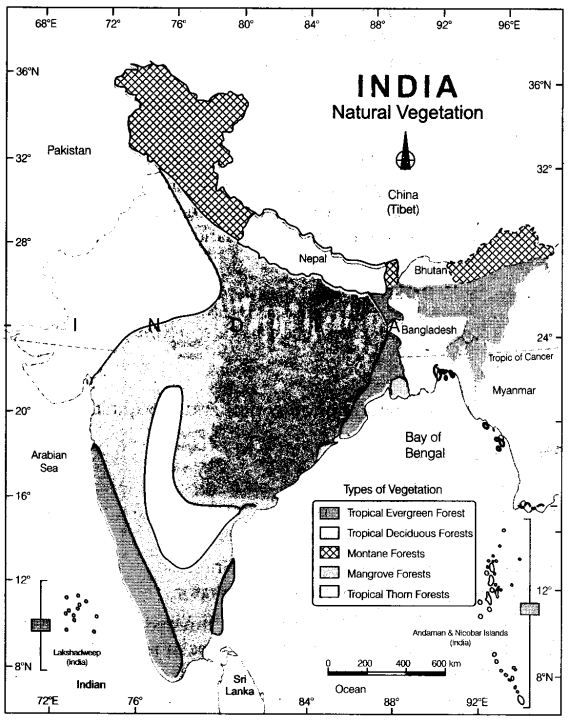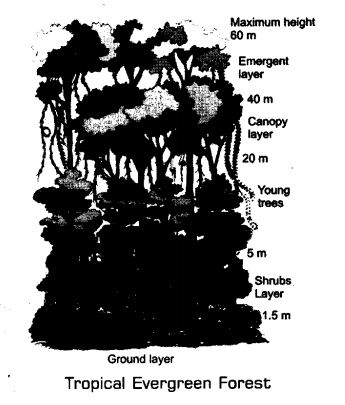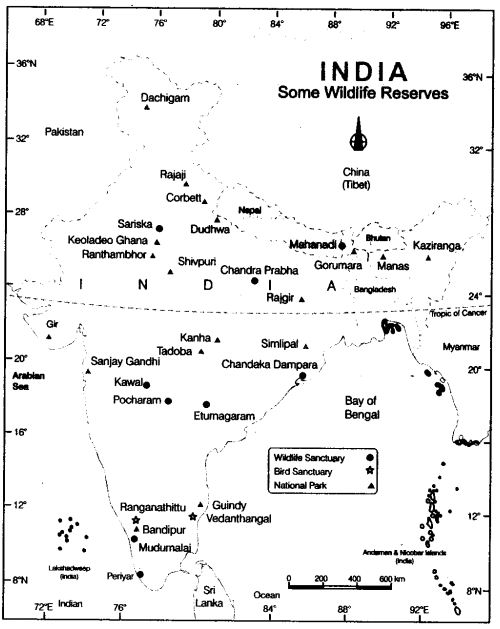Notes For All Chapters Geography Class 9 CBSE
India is one of the twelve mega bio-diversity countries of the world. They are a group of countries that have the majority of the Earth’s species and therefore, considered extremely bio-diverse.
Being a vast country, India having 47,000 plant species (out of which 15,000 are flowering plants, i.e. 6 per cent in the world), occupies 10th position worldwide and 4th in Asia. Non-flowering plants such as ferns, algae and fungi also grow here. It also has around 90,000 species of animals (including marine and water fishes) and insects.
Natural Vegetation
Natural or virgin vegetation means the plant community which has grown naturally without any human intervention for a long time. That natural vegetation, which are left undisturbed over a long period of time are called virgin vegetation.
Virgin vegetation are of two types
- Endemic species Those plant species which originated from the country, are termed as endemic species.
- Exotic species Those plant species which originated outside the country are termed as exotic species.
Factors Affecting Diversity
Factors which influence the variety of flora and fauna include Relief (land and soil), Climate (temperature, photoperiod and precipitation) and the Ecosystem. These are as follows
Relief
It includes land and soil.
Land
It affects the natural vegetation both directly and indirectly. The nature of the land i.e. whether it is plain, hilly or a plateau, determines the kind of vegetation which will grow in it. Fertile lands are used for growing crops, vegetables and fruits.
Undulating (Wavy) and rough surfaces generally develop either into grasslands or woodlands (forests). Different types of land accordingly sustain and provide shelter to different kinds of wildlife.
Soil
The soils also vary place to place. Different kinds of soils provide different kinds of vegetation. For example, alluvial or deltaic soil of a river delta near the sea will sustain mangrove forests while slopes of hills have conical trees. The sandy soils of desert sustain thorny bushes.
Note Animals and birds also inhabit locations based on relief. For example, migratory birds like the Siberian cranes and flamingoes are found to nest in the wetlands of the Rann of Kuchchh, where the desert merges with the sea.
Climate
It includes temperature, photoperiod and precipitation.
Temperature
The temperature along with the humidity in the air and precipitation determine the character of vegetation and its extent.
As the climate gets colder, either by increase in altitude (above 915m) or by going away from the equator, the vegetation will change from tropical to sub-tropical, temperate and then alpine.
For example, on the slopes of the Himalayas and hills of the Peninsula, the fall in temperature affects the type of vegetation and its growth.
Photoperiod (Sunlight)
The amount and duration of sunlight is known as photoperiod. The difference in latitude, altitude and season brings variation in duration of sunlight in different places. In warmer regions and climates, plant growth is faster due to longer duration of sunlight, especially with availability of adequate moisture. An instance is the fact that the Southern slopes of the Himalayas are covered with thicker vegetation than the Northern slopes.
Precipitation
Advancing South-West monsoon (June to September) and retreating North-East (October- November) monsoons bring almost all the rainfall in India. Areas of heavy rainfall always have denser vegetation than other areas with lesser rainfall. The South-West monsoon rains on the windward side of the Western Ghats, thus cause a heavy growth of tropical evergreen forests there, whereas the leeward side does not have any such forests.
Ecosystem
Various species of plants occur in areas having similar climatic conditions. To a large extent its nature determines the animal life in that area. All the plants and animals in an area are interdependent on each other in their physical environment and form an ecosystem.
Thus, an ecosystem is a biological environment consisting of all the organisms living in a particular area, as well as all the non-living, physical components of the environment with which the organisms interact, such as air, soil, water and sunlight.
Biome
It is a major community of plants and animals having similar life forms existing under similar environmental conditions. A biome is identified on the basis of plant existing there. It is also termed as ‘major life zone’.
Human Influence In an Ecosystem
Human beings influence ecosystem in the following manner
- They utilise the vegetation and wildlife.
- The greed of human beings leads to over utilisation of natural resources.
- Human beings cut the trees and kill the animals creating ecological imbalance.
- Due to the activities of human beings, some of the ‘ plants and animals have reached the verge of extinction.
Importance of Forests
Forests are advantageous for the environment. They influence climate, reduce soil erosion, regulate stream flow, provide raw material for industries and livelihood for many, etc. They control wind force and temperature and cause rainfall. They also provide shelter to various animal species.
Change in Nature of Vegetation in India
Factors like growing demand for cultivated land, development of industries and mining, urbanisation have changed natural vegetation. The vegetation cover of India in large parts is no more natural in the real sense, except in some inaccessible regions like the Himalayas, the hilly region of Central India and the Marusthali. In most of the places, it is either modified, replaced or degraded by human interference.
Types Of Vegetation
Relief and climatic factors develop different types of vegetation. Based on the major forest types, India has following types of vegetation.
- Tropical Evergreen Forests
- Tropical Deciduous Forests
- Tropical Thorn Forests and Scrubs
- Montane Forests
- Mangrove Forests
Note: According to India State of Forest Report (SFR) 2015, the forest cover in India is 21.34% which was 21.05% in the year 2011.
1. Tropical Evergreen Forests
These are also called tropical rainforests. They cover about 12% of the total forested areas of India. They are found in areas where the annual rainfall is over 200 cm.
Regions of Occurrence
Western slopes of the Western Ghats, both groups of islands (Lakshadweep, Andaman and Nicobar Islands), upper parts of Assam and some parts of the coasts of Tamil Nadu and Odisha.
Characteristics of Tropical Evergreen Forest
- As these areas are warm and wet almost throughout the year, they have abundant vegetation with tall trees (up to 60 m), creepers and bushes.
- The vegetation occurred in a multilayered structure.
- These appear green throughout the year, as the trees shed their leaves at different times.
Flora and Fauna
Ebony, mahogany, cinchona, rubber and rosewood trees are useful commercial trees found here. Animals found here include rhinoceros, elephants, various species of monkey, lemur, deer, many bird varieties, bats, sloth, scorpions and snails.
2. Tropical Deciduous Forests
These cover about 64% of the fetal forested areas of the country and are the most abundant variety of forests in India. These are also called monsoon forests and also spread over the region receiving rainfall between 200 to 70 cm. Trees of this forest type shed their leaves for about 6 to 8 weeks in dry summer.
Types of Tropical Deciduous Forest
On the basis of the availability of water, these forests are further divided into moist and dry deciduous.
Moist Deciduous
Forests growing in annual rainfall areas between 100 and 200 cm are classified as moist deciduous. They cover about 34% of the country’s forested area.
They are found mostly in the Eastern part of the country such as North-Eastern states, West Odisha, Jharkhand, Chhattisgarh, foothills of the Himalayas and the leeward side of the Western Ghats. Teak (dominant species), bamboo, sal, shisham, sandalwood, khair, kusum, arjun and mulberry trees are found in these forests.
Dry Deciduous
Forests growing in annual rainfall areas between 70 and ‘100 cm are classified as dry deciduous. They cover about 30% of the country’s forested area. These are found in rainier parts of the Peninsular plateau and the plains of Uttar Pradesh and Bihar.
Teak, sal, peepal and neem trees grow in these areas. Many parts of these areas have been cleared for agricultural activities and for grazing. Besides lions, tigers, elephants, pigs and deer many varieties of birds, lizards, snakes and tortoises are found in these forests.
3. Tropical Thorn Forests and Scrubs
These cover about 5% of the total forested areas of India. These are found in areas where the annual rainfall is less than 70 cm.
Region of Occurrence
These are found in North-Western part of the country including semi-arid areas of Gujarat, Rajasthan, some areas of Uttar Pradesh, Chattisgarh, Haryana and Madhya Pradesh, as well as parts of the Deccan Plateau.
Characteristics of Tropical Thorn Forests and Scrubs
The trees found in tropical thorn forest and scrubs are scattered.
Other such plants which have long roots, succulent stems and small thick leaves are also found here.
All these characteristics have developed to minimise evaporation and conserve moisture. Only scrubs are found in desert areas with the least rainfall.
Flora and Fauna
Trees like acacia palm euphorbia and cactus found in these areas. Fox, wolf, rats and mice, wild ass, horses, tiger, lion, camels and similar animals are found in these areas.
4. Montane Forests
These forests cover about 17% of the total forested areas of India and are found in mountainous areas of Jammu and Kashmir, Himachal Pradesh, Uttarakhand, Sikkim and Arunachal Pradesh. Natural vegetation changes with corresponding change in temperature with increasing altitude in the mountainous region. These succession of natural vegetation belts is same as in the order from tropical to tundra vegetation.
Altitudinal Distribution of Montane Forests
- Wet Temperate Forest At lower altitude between 1,000-2,000 m, wet temperate forests with evergreen broad leaf trees such as oaks and chestnuts are prominent.
- Temperate Forest At the altitude between 1,500-3,000 m, temperate forests containing coniferous trees like pine, deodar, silver fir, spruce and cedar are found. These forests cover mostly the Southern slopes of the Himalayas, places having high altitude in Southern and North-East India.
- Temperate grasslands These are found at higher elevations. At high altitude above 3,600 m, temprate forest and grasslands give way to the alpine vegetation.
- Alpine vegetation This vegetation through shrubs and scrubs merge into alpine grasslands. These area extensively used by nomadic tribes like Gujjars and Bakarwals for grazing.
- Tundra vegetation Mosses and lichens are part of tundra vegetation are found at higher altitudes.
Flora and Fauna
Kashmir stag, spotted dear, wild sheep, jack rabbit, Tibetan antelope, yak, snow leopard, squirrels, shaggy horn wild ibex, bear and rare red panda, sheep and goats with thick hair are found here. Silver firs, pines, junipers, birches, etc are trees common here.
5. Mangrove Forests
These are found in coastal delta areas influenced by sea tides. Due to this fact, they are also called tidal forests. The roots of the predominate mangroves are submerged under water. Such forests are found in the delta areas of rivers oh the East coast of India (Ganga, Brahmaputra, Mahanadi, Godavari, Krishna and Kaveri) due to mud and silt brought down by the rivers.
Flora and Fauna
- In the Ganga-Brahmaputra delta, sundari trees providing durable timber are prominent. Other trees are palm, coconut, keora and agar.
- Animals found here include the Royal Bengal Tigers, snakes, turtles, gharials and crocodiles.
Wildlife
India is also rich in its fauna (animal life) same as in flora (plant life). It has approximately 90,000 animal species and 2,000 species of birds.
They constitute 13% of the total world’s stock. There are 2,546 species of fish, which account for nearly 12% of the world’s stock.
It also shares between 5 and 8 % of the world’s amphibians, reptiles and mammals. The existence of animals in our country varies place to place.
Distribution of Wildlife in India
The elephants are the most majestic animals among the mammals. They are found in the hot wet forests of Assam, Karnataka and Kerala.
One-horned rhinoceroses are the other animals, which live in swampy and marshy lands of Assam and West Bengal.
Arid areas of the Rann of Kachchh and the Thar desert are the habitat for wild ass and camels, respectively.
India is the only country in the world that has both tigers and lions. The natural habitat of the Indian lion is the Gir forest in Gujarat. Tigers are found in the forests of Madhya Pradesh, the Sunderbans of West Bengal and the Himalayan region.
Leopards too are members of the cat family. They are important among animals of prey.
The Himalayas harbour a hardy range of animals, which survive in extreme cold. Ladakh’s freezing high altitudes are a home to yak, the shaggy horned wild ox (weighing around 1 tonne) the Tibetan antelope, the bharal (blue sheep), wild sheep and the kiang (Tibetan wild ass).
The ibex, bear, snow-leopard and very rare red panda are found in certain pockets.
In the rivers, lakes and coastal areas, turtles, crocodiles and gharials are found.
The gharial is the only representative of a variety of crocodile, found in the world today.
Birdlife in India is colourful. Peacocks, pheasants, ducks, parakeets, cranes and pigeons are some of the birds inhabiting the forests and wetlands of the country.
Indian bison, nilgai (blue bull), chousingha (four homed antelope), gazel and different species of deer are some other animals found in India in different places. It also has several species of monkeys.
Note: The Gir Forest is the last remaining habitat of the Asiatic lion.
Wildlife Protection Act was implemented in 1972 in India.
Migratory Birds
Some of the wetlands of India are popular with migratory birds. During winter, birds such as Siberian crane come in large numbers. One such place favourable with birds is the Rann of Kutch. At a place where the desert merges with the sea, flamingo with their brilliant pink plumage, come in thousands to build nest mounds from the salty mud and raise their young ones. It is one among many extraordinary sights in the country.
Need Of Environment Conservation
Our crops consist of edible plants from a bio-diverse environment. Many medicinal plants are also used by us. The animals were selected from large stock provided by nature as milch animal. They also provided us draught power, transportation, meat, eggs.
The fish provide nutritive food. Many insects help in pollination of crops and fruit trees. They also exert biological control on such insects which are harmful. Thus, it can be said that every species has a role to play in the ecosystem. So, its conservation is essential.
Due to excessive exploitation of the plants and animal resources by human beings, the ecosystem has been disturbed. About 1,300 plant species are endangered and 20 species are extinct. Quite a few animal species are also endangered and some have become extinct.
Summary
India is one of the twelve mega biodiverse countries in the world.
The plant community which has grown naturally without human intervention are called natural vegetation.
Natural vegetation which are left undisturbed by human for a long time is termed as virgin vegetation.
The type of virgin vegetation which are purely Indian are called Endemic or Indigenous species.
The virgin vegetation which comes from outside the country are called exotic species.
Various,relief and climatic factors are responsible for distribution of natural vegetation.
Land and soil are the relief factors affecting the type of vegetation.
Temperature, photoperiod and precipitation are the climatic factor affecting vegetation of a region.
Based on temperature, vegetation zones are divided into Tropical, Sub-tropical, Temperate and Alpine type.
Forest are renewable resources and play major role in enhancing quality of Environment.
Most of India’s natural vegetation are found in Himalayas, hilly regions of central India and in desert.
Biomes are very large ecosystem on land and have distinct types of vegetation and animal life.
Major vegetation types identified in India are tropical evergreen forests, tropical deciduous forests, tropical thorn forest and scrubs, montane forests and Mangrove forests.
Tropical Evergreen forest is found in region of very high rainfall.
Tropical deciduous forest or monsoon forests are the most widespread forests of India.
The thorn forest and scrubs are found in region with less that 70 cm rainfall.
Montane forests are high altitude alpine vegetation.
Mangroves are tidal vegetation found along the coastal region. Sundari is an important mangrove tree.
The World Conservation Union publishes Red list of critically threatened and endangered plant species.
India has 13% of the world’s total bird species and 12% fish stocks.
The Wildlife Protection Act in India was implemented in 1992.
The excessive exploitation of the plants and animal resources by Human beings led them to become endangered and extinct.
Hunting, pollution, the introduction of alien plant and animal species, deforestation are major threats for the ecosystem.
Government of India has taken many steps to protect plant and animals such as – setting up of national parks, biosphere reserves etc, the introduction of different projects to conserve critically endangered species e.g. project tiger, project rhino etc.
We all should be aware of the fact that a natural ecosystem is very important for our survival.




Leave a Reply